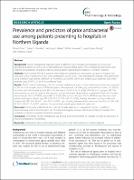| dc.contributor.author | Ocan, MOSES | |
| dc.contributor.author | Manabe5, Yukari C. | |
| dc.contributor.author | Baluku, Hannington | |
| dc.contributor.author | Atukwase, Esther | |
| dc.contributor.author | Ogwal-Okeng, Jasper | |
| dc.contributor.author | Obua, celestino | |
| dc.date.accessioned | 2019-10-31T06:47:39Z | |
| dc.date.available | 2019-10-31T06:47:39Z | |
| dc.date.issued | 2015 | |
| dc.identifier.citation | Ocan, M., Manabe, Y. C., Baluku, H., Atukwase, E., Ogwal-Okeng, J., & Obua, C. (2015). Prevalence and predictors of prior antibacterial use among patients presenting to hospitals in Northern Uganda. BMC Pharmacology and Toxicology, 16(1), 26. | en_US |
| dc.identifier.uri | https://hdl.handle.net/123456789/76 | |
| dc.description.abstract | Background: Human antibacterial exposure occur in different ways including consumption of animal and
agricultural products as well as use of prescribed and non-prescribed agents. We estimated the prevalence and
explored the predictors of antibacterial use among patients presenting to hospitals in northern Uganda.
Methods: Four hundred fifty (450) patients were randomly selected and antibacterial use prior to hospital visit
measured using a questionnaire and urine antibacterial activity assay. Urine antibacterial bioassays were performed
using American type culture collections of Escherichia coli, Bacillus subtilis and Streptococcus pyogenes. Data were
analysed using STATA 12.0 at 95 % confidence level.
Results: Of 450 patients interviewed, 62.2 % had used antibacterial agents. Urine antibacterial activity was detected
in 30.4 % of the samples tested. Of the 85 patients who reported not taking any antibacterial at home, 16 (18.8 %)
had urine with antibacterial activity. Most test bacteria, E. coli (74.5 %), B. subtilis (72.6 %) and S. pyogens (86.7 %)
were sensitive to urine of patients who reported using antibacterial drugs before hospital visit. From the interview,
metronidazole 15.6 % (70/450), amoxicillin 12 % (54/450), and ciprofloxacin 10.4 % (47/450) were the most used
antibacterial agents. Patient age (OR, 2.45: 95 % CI: 1.02–5.91: P = 0.024), time-lag between last drug intake and
hospital visit (OR: 3.18: 95 % CI: 1.44–7.0: P < 0.0001), and time-lag between illness onset and hospital visit (OR: 1.89:
95 % CI: 0.38–5.1: P = 0.027) predicted the use of antibacterial agents before hospital visit.
Discussion: Community antibacterial use continues to take place in an unregulated manner. In addition,
physiciansrarely seek to ascertain prior use of antibacterial agents among patients presenting to hospitals. This
couldhave a bearing on patient treatment outcomes.
Conclusion: Knowledge of prior antibacterial use among patients presenting to hospitals is useful to physicians in
ensuring antibacterial stewardship. | en_US |
| dc.language.iso | en | en_US |
| dc.publisher | BioMed Central | en_US |
| dc.subject | Antibacterial use | en_US |
| dc.subject | Patients | en_US |
| dc.subject | Uganda | en_US |
| dc.subject | Northern Uganda | en_US |
| dc.subject | Urine antibacterial bioassay | en_US |
| dc.subject | Self-report, | en_US |
| dc.subject | Self-report, Self-medication | en_US |
| dc.title | Prevalence and predictors of prior antibacterial use among patients presenting to hospitals in Northern Uganda | en_US |
| dc.type | Article | en_US |

